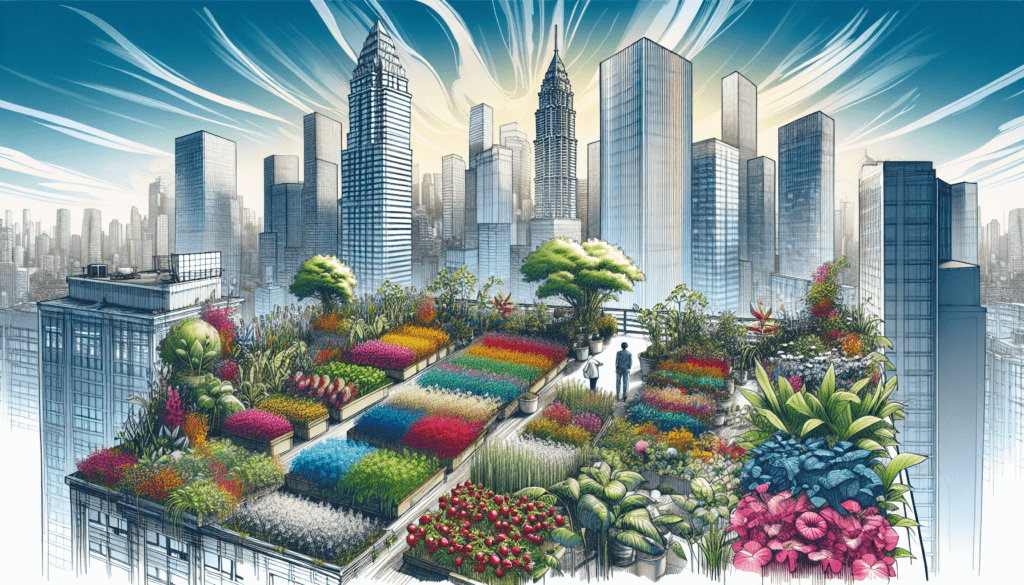Living in a bustling city with limited green spaces can make gardening seem like an impossible feat. However, urban gardening is a growing trend that embraces the art of cultivating plants in small spaces, such as balconies, rooftops, or even indoor settings. It provides city dwellers with an opportunity to reconnect with nature, improve their well-being, and contribute to a more sustainable and environmentally-friendly future. In this article, we will explore the concept of urban gardening, its benefits, and offer practical tips to get started on your own green oasis in the heart of the concrete jungle. So grab your gardening gloves and let’s embark on this vibrant journey together! Urban gardening refers to the practice of growing plants and cultivating gardens in urban spaces such as rooftops, balconies, backyards, and community areas. This form of gardening has gained popularity in recent years as more people are realizing the benefits it offers. Gardening in an urban environment allows individuals to connect with nature, grow their own food, beautify the surroundings, and create a sense of community. It is a way to make the most of limited space and resources and contribute to a greener and more sustainable urban landscape. In this article, we will explore the definition, benefits, challenges, and importance of gardening in an urban environment, as well as different types of urban gardening and tips for creating and maintaining an urban garden.

Definition of Urban Gardening
Urban gardening involves the cultivation of plants, flowers, and vegetables in urban spaces. It utilizes various techniques such as container gardening, vertical gardening, rooftop gardening, and community gardening. The primary goal of urban gardening is to optimize the available space in cities and urban areas to grow plants and create green spaces. It is a practice that brings the beauty and benefits of nature into urban settings, making cities more livable and sustainable.

Benefits of Gardening in Urban Environment
Gardening in an urban environment offers numerous benefits to individuals, communities, and the environment. Firstly, it provides a connection to nature, allowing urban dwellers to experience the therapeutic aspects of gardening and enjoy the beauty of plants and flowers. This connection to nature has been found to reduce stress, improve mental well-being, and promote overall happiness.
Secondly, urban gardening allows individuals to have more control over their food supply. By growing their own fruits, vegetables, and herbs, urban gardeners can ensure the quality and freshness of the produce they consume. This promotes healthier eating habits and reduces reliance on store-bought produce, which may be treated with pesticides and other chemicals.
Furthermore, gardening in an urban environment promotes environmental sustainability. Plants in urban gardens help to improve air quality by absorbing carbon dioxide and releasing oxygen. They also play a role in reducing the urban heat island effect by providing shade and cooling effects. Additionally, urban gardens can contribute to the conservation of biodiversity and create habitats for birds, butterflies, and other pollinators.
Lastly, urban gardening fosters a sense of community and social interaction. Community gardens, in particular, bring people together, encourage collaboration, and promote cultural diversity. They provide a space for sharing knowledge and resources, as well as a platform for community events and activities. Urban gardening projects can strengthen social bonds, create a sense of ownership and belonging, and enhance the overall quality of life in urban neighborhoods.

Challenges of Gardening in Urban Environment
While gardening in an urban environment has many advantages, it also presents some challenges that gardeners need to overcome. One major challenge is limited space availability. Urban areas are often characterized by small yards, balconies, or shared public spaces, which may not provide enough room for large gardens. This requires creative solutions such as vertical gardening or using containers to make the most of the available space.
Another challenge is managing sunlight and shade. Tall buildings, trees, and other structures can cast shadows that limit the amount of sunlight reaching the plants. Proper positioning and selection of shade-tolerant plants are essential to ensure successful growth in these conditions.
Soil pollution and contamination can also pose challenges in urban gardening. Urban soils may contain heavy metals, chemicals, or other pollutants due to past industrial activities or urban runoff. Testing and remediation of the soil may be necessary before planting to ensure the safety of the plants and the food they produce.
Addressing limited water access is another hurdle in urban gardening. In urban areas, water sources may be limited or expensive to use. Efficient watering systems such as drip irrigation or rainwater harvesting can help conserve water and ensure the plants receive the necessary moisture.
Lastly, minimizing the effects of wind and air pollution on urban gardens can be a challenge. Strong winds can damage plants, while air pollution can negatively impact their growth and health. Providing windbreaks, such as fences or trellises, and choosing plants that are tolerant to pollution can help mitigate these challenges.

Importance of Gardening in Urban Environment
Gardening in an urban environment is of paramount importance for several reasons. Firstly, it allows individuals to reconnect with nature and create green spaces in concrete jungles. By incorporating plants and gardens into urban landscapes, we can improve the aesthetic appeal of cities and create a more pleasant and enjoyable environment for everyone.
Secondly, gardening in an urban environment promotes self-sufficiency and food security. As urban populations increase, it becomes crucial to explore alternative methods of food production. By growing our own food in urban gardens, we can reduce our reliance on long-distance transportation and commercial farming, which contribute to greenhouse gas emissions and environmental degradation.
Furthermore, urban gardening plays a vital role in promoting sustainability and mitigating climate change. Plants and trees help to absorb carbon dioxide, a major greenhouse gas, and release oxygen, thus improving air quality and reducing the carbon footprint. Urban gardens also help to mitigate the urban heat island effect by providing shade and cooling effects, thus reducing the energy consumption required for air conditioning.
In addition to the environmental benefits, gardening in an urban environment fosters social interaction and community engagement. Community gardens, in particular, serve as gathering spaces, where people from diverse backgrounds come together and build meaningful connections. They provide a platform for education, skill-sharing, and cultural exchange, nurturing a strong sense of community and belonging.
In conclusion, gardening in an urban environment offers numerous benefits and opportunities for individuals, communities, and the environment. Despite the challenges posed by limited space, sunlight, soil pollution, water access, and air pollution, urban gardening allows individuals to connect with nature, grow their own food, promote sustainability, and build vibrant communities. By incorporating nature into urban landscapes, we can create a greener, more livable, and sustainable future for our cities.



